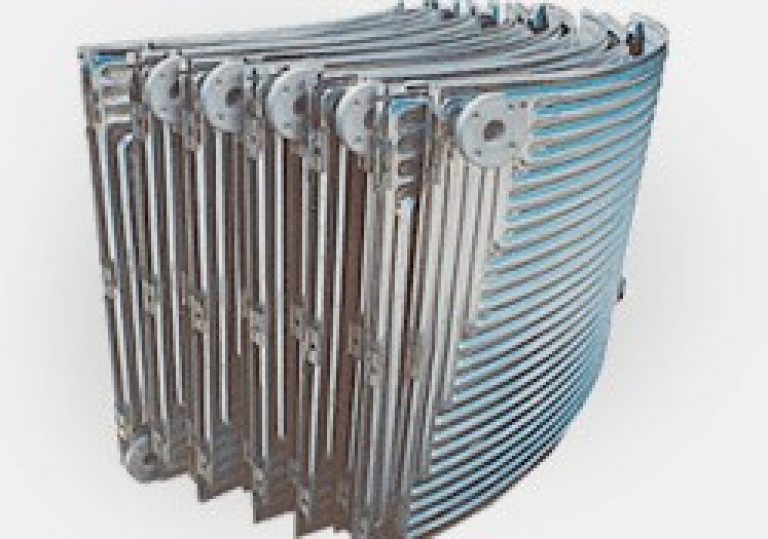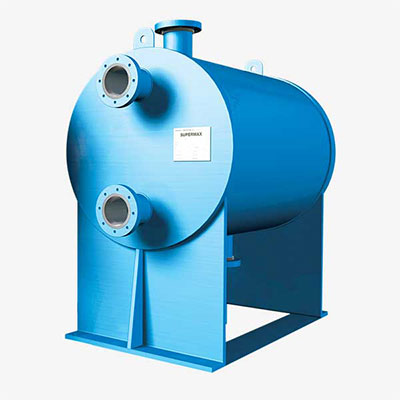Prime Surface Heat Exchanger
prime surface heat exchanger
heat exchangers
Tranter® PLATECOIL® Prime Surface Heat Exchanger
Tranter PLATECOIL® Prime Surface Heat Exchangers deliver efficient and uniform thermal control in immersion duty; jacketing vessels, reactors or dryer shells; within fluidized beds or configured as gas phase heat recovery banks. In thermal processing of any kind, PLATECOIL exchangers give you better thermal control than pipe coil, half pipe, dimple sheet or gridcoil.
Processors worldwide have used PLATECOIL to:
- Eliminate sparging for reduced water and steam consumption
- Capture waste energy from moist, wet flue gases at temperatures as low as 67°C (150°F)
- Recycle low-grade heat energy from drains
- Improve economic performance in existing tanks and vessels using clamp-on retrofits
These highly versatile exchangers conform to ISO 9001 standards for design, manufacture and testing for either one-off, special fabrications or high-volume engineered subsystems.
Consider all the factors—flow rate, flow balance, heat transfer coefficient, durability—PLATECOIL is engineered and crafted for faster start-ups, constant temperatures, better control and longer service life.
Engineering Shapes PLATECOIL® Efficiency

Essentially two sheets welded together, one or both of which is die-formed, PLATECOIL panels comprise a series of passages through which a heating or cooling media flows. Three styles of Multi-Zone and two styles of Serpentine flow configurations ensure that you get the right combination of flow rate and heat transfer rate with steam, gases or liquids. In designing individual solutions with PLATECOIL, Tranter engineers use advanced computational fluid dynamics (CFD) modeling to determine factors such as heat transfer coefficients and convection effects.
Der er tre mulige design af multi-zone og to design af flow konfigurationer der sikrer, at du får den rigtige kombination af flowhastighed og varmetransmissionshastighed med damp, gasser eller væsker ved at væsken enten strømmer igennem kanalerne i serie eller i parallel. For at designe individuelle løsninger med PLATECOIL bruger Tranter-ingeniører avanceret CFD-modellering (computerriseret fluid dynamics) til at bestemme faktorer som varme overførings koefficienter og konvektionseffekter.
PLATECOIL flow patterns applied for steam provide reserve capacity to compensate for intermittent overloads during start-ups, distributing steam virtually instantaneously to all levels of the plate. Under load swings, PLATECOIL attains desired operating temperatures extremely rapidly, with minimum variation. PLATECOIL styles for liquid heating or cooling media, including hot oil or refrigerants, promote high internal flow velocities for high heat transfer rates.
More than 300 sizes are available, with widths ranging from 305 mm to 1090 mm (12 in. to 43 in.) and lengths spanning 585 mm to 3630 mm (23 in. to 143 in.).
A wide variety of materials, gauges and finishes are available. Connection options are 3/4 in. to 2 in. NPT or flange.
Light Gauge, Corrosion-Resistant ECONOCOIL®

ECONOCOIL® hydraulically expanded panels are a special PLATECOIL variant available in an assortment of single-embossed or double-embossed styles and sizes in serpentine or parallel passes. Titanium construction provides long service life where highly corrosive environments exist. Light-gauge titanium ECONOCOIL panels provide better thermal conductivity than units constructed from heavy-gauge material. High turbulence results in low scaling/fouling tendency on external and internal surfaces.
Typical ECONOCOIL Applications
- Sulfate chrome plating solutions
- Chromic acid, 10% boiling
- Nickel plating solutions (except electroless nickel with fluorides)
- Inhibited sulfuric acid
- Inhibited hydrochloric acid
- Hypochlorites
- Seawater or salt brine
- Chlorinated hydrocarbons
- Flue gas heat recovery
- Stack gas heating
PLATECOIL vs Pipe Coil
| PLATECOIL | PIPE COIL |
|---|---|
| Multi-Zone flow arrangement for controlled steam distribution | Controlled steam flow not possible |
| Rapid removal of condensate for high heat transfer rates | Susceptible to condensate blocking, poor heat transfer rates, waterhammer |
| Factory-controlled, economical modular manufacturing | Costly labor-intensive welding, extensive support structures |
| Economical fabrication in higher alloys | Higher alloys usually not practical or possible |
| Can be formed into virutally any shape | Limited shape possibilities |
| Weighs 50-70% less | Heavy, large-footprint fabrications, only half the surface area for equivalent footprint |
When to Consider
Configure PLATECOIL as banks…you’ll benefit from lower engineering, fabricating and maintenance costs. In tanks, compact PLATECOIL banks give you twice the sur face area in a given space, at half the weight as equivalent pipe coil.
PLATECOIL banks’ rigid design requires fewer supports, requiring less labor for installation and making replacement easier.
In tanks or vats, the PLATECOIL planar shape induces a “chimney effect” for natural convection circulation and improved heating uniformity. Countercurrent flow circuits maximize heat transfer, while wide interspaces and open turns effectively pass solids or fibers. PLATECOIL panels can efficiently recover heat from dirty wastewater, reducing thermal pollution. Cleaning is much simpler, because entire units are removable without dumping the solution. PLATECOIL heat recovery banks in wet gas and liquid streams cut industry fuel bills significantly. At the same time, they knock out troublesome vapor plumes and reduce thermal load on effluent plants. Wet flue gas streams as low as 67°C (150°F) are a candidate for big savings from PLATECOIL heating banks.
PLATECOIL banks can also be configured within a shell as a shell & plate exchanger where other heat exchangers are impractical because of fouling, particle plugging and/or high viscosity. These units are finding success as sulfur remelters, asphalt emulsion coolers and thermosyphon and kettle reboilers.
- MAWSA Zebra Mussel ReportOpens in a new tab

